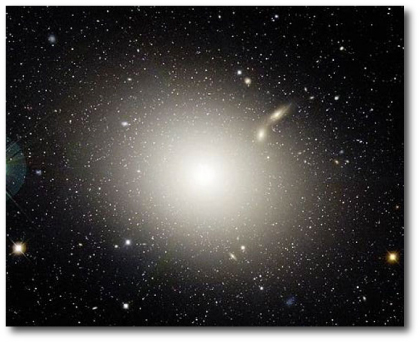
Image Source.
Yesterday, the Texas group announced their discovery of a new two-planet system orbiting HD 155358. Assuming that they’ve drawn a more-or-less edge-on configuration, the inner planet has a bit less than a Jupiter mass and orbits the solar-type parent star in 195 days. The outer planet has about half a Jupiter mass and orbits in 530 days. Dynamically, the system is reminiscent of an overclocked Jupiter and Saturn (although the planets lie far enough away from the 5:2 commensurability so as to avoid the indignities associated with the great inequality).
The main angle on HD 155358 is the low metallicity. The star has [Fe/H]=-0.68, which means that its iron abundance is only 21% that of the Sun. It’s rare to find giant planets around a star that’s so anemic. What exactly happened that allowed HD 155358b and c to beat the odds by assembling cores and accreting enough gas to become full-fledged giant planets?
There were probably a number of contributing factors. HD 155358 may have had a relatively long-lived protostellar disk. In all likelihood, that disk was probably considerably more massive than average. Although HD 155358 is iron-poor, I bet it’ll turn out to be relatively overabundant in oxygen and silicon (that is, a core-accretion formation scenario would prefer supersolar [Si/Fe] and [O/Fe] for HD 155358, see here for more details). Giant planet cores are made from volatiles, and so it’s the oxygen, not the iron, that’s the critical element.
HD 155358, with its ~10 billion year age, and (possibly) enhanced [O/Fe] would be very much at home in a giant elliptical galaxy like M87.

Image Source.
At times, oklo.org likely seems rather provincial. The scope of discussion here rarely ranges beyond the distances of a few hundred light years that mark our local stellar neighborhood. It’s easy to forget that there are a hundred billion galaxies within our cosmological horizon. Each galaxy contains billions of planets.
A bruiser like M87 packs trillions of stars, many of which formed during the ferocious galactic mergers that occurred roughly 10 billion years ago at redshift z~2. (I like this Java applet for computing ages, redshifts and lookback times for the Universe as a function of fundamental cosmological parameters). Many of the stars in giant ellipticals have metallicities that are similar to or even greater than solar, and because older stellar populations tend to have higher [O/Fe], it’s nearly certain that collossal numbers of planets were forming during the epoch when the giant ellipticals were being assembled.
To the best of our knowledge, it takes 4.5 billion years from the epoch of planetary formation to the point where technology and directed information processing emerge. This means that when we look back at elliptical galaxies at redshift z~0.65, we’re seeing what may have been the Universe’s golden age — the time and the environment when the density of civilizations was the highest that it will ever be. What happened to them? Where are they now?

Hi Greg,
Are we getting a tad bit philosophical here? I never heard of a redshift of z~0.65 referred to quite that way before, i.e. “the Universe’s golden age”. But, it is certainly something that is a source for wonderment. ;-)
Best,
Eric
Hi Greg,
I apologize for being so flippant in my last response to your blog. But, when you try to establish a proper database that is to serve as a control group (i.e. the systemicJR_series) almost on your own, you tend to forget the big picture.
This universe in which we all live is far vaster and older than Edwin Powell Hubble could have imagined, much less Harlow Shapley. And, at least as far as the present day consensus is concerned, our universe is 13.7 billion years old (come next April 1, 2008 J/K LOL) and is flat and therefore is infinite and will expand forever.
Now there are many galaxies, some spiral, some elliptical, some colliding (turning into something else) and some irregular. When we look further back in distance with our brilliant telescopic ingenuity we are looking back into time in proportion to the Hubble constant, which I believe at last measurement was at 70-74 kilometers per second per mega parsec with a total uncertainty of 10% when last measured.
Now, according to some planetary scientist if life doesn’t begin within the first million years of a planet’s formation, such as the Earth, then it will never begin. Now I and no one else knows if that is true. But, if it is true, then that means that the earlier galaxies in the Hubble Deep Field with z~5.6-6.4 may have evolved intelligent life forms capable of very advanced technology long before our spectral class G2 V star was even a glimmer in the supernova(e) and/or galactic density wave’s eye. But then again time is relative. The same could be said of our galaxy or for that matter any galaxy. For all we know the “golden age of the universe’ may have a occured 13 billion years ago. Or maybe, there wasn’t just one “golden age of the universe” but many. Perhaps, there is another one about to occur in our own galaxy. Something to think about.
Eric
Upon further reflection the locution “golden age of the universe” is in one sense an oxymoron. I understand what Greg means by that, but from a different perspective it is senseless. Please let me explain. In order for there to be a “golden age of the universe” by definition such an age would have to be ubiquitous. But in a universe which, at the present time, is regarded as infinite, by definition a “golden age” can never be ubiquitous and therefore universal. It would defy the laws of physics, mathematics and logic.
But in the finite realm it is conceivable that there could be a “golden age” of a galaxy, or one or two or more. Just a thought.
Eric
Hi Greg,
Please excuse the rather sketchy comments above, but I have friends over last night, because I needed to blow off a little steam. And, I had a little bit too much to drink and wasn’t thinking very clearly about what I was writing last night.
Now that I’m sober and well rested I realize that 13 billion years ago is too early for any life to have formed. And, I don’t imagine there were too many habitable planets around if any at all because the necessary material (i.e. metals) were not in sufficient quantity to form any terrestial like planets, much less any life.
But, I am curious why you chose a redshift of 0.6 for when advanced civilizations may have been abundant. The reason why I say this is because of the work on Sandra Faber. As I’m sure you know she has been conducting a survey of the spectra of distant galaxies in an attempt to see if the elements for planets and life were in sufficient quantities at various time in the history of our universe. Now, I’m not sure off-hand how far back into time her survey has taken her, but I do know that the spectra every single galaxy that she and her team have survey contained sufficient quantities of metals for planet building and in particular sufficient quantities of the elements necessary for life, i.e. Carbon, Nitrogen and Oxygen.
Now bearing these results in mind if you consider that theory of the existence of Population III stars is correct–stars formed from supermassive clouds of hydrogen long before the formation of the first galaxies then it doesn’t seem so implausible that very technological advanced civilizations might have arisen as early as 8 billion years ago in parts of our universe. And it is concievable that there may have been an abundance of them by 4 billion years given the time frame that you mention above. And, if it is true that if life doesn’t evolve within the first million years of a planet’s formation, then it makes it even more plausible that a high density of advanced civilizations could have emerged at a considerably earlier period than the one represented by a redshift of z~0.65.
Now, perhaps I am missing something here, which is quite possible, but why in particular a redshift of z~0.65? If my reasoning is flawed I would welcome any feedback from you on this. You really got me thinking about this.
Best,
Eric
Oops! I used the Cosmology Java Applet and set the Hubble constant at 72 kilometers per second per mega parsec, and found out why you chose a redshift of z~0.65 as the point in cosmic history that most likely was the “golden age” of the universe. I even did the calculations by hand a pretty much got the same result. Sorry about that Greg. Mea Culpa. I should have checked the numbers first.
Best,
Eric